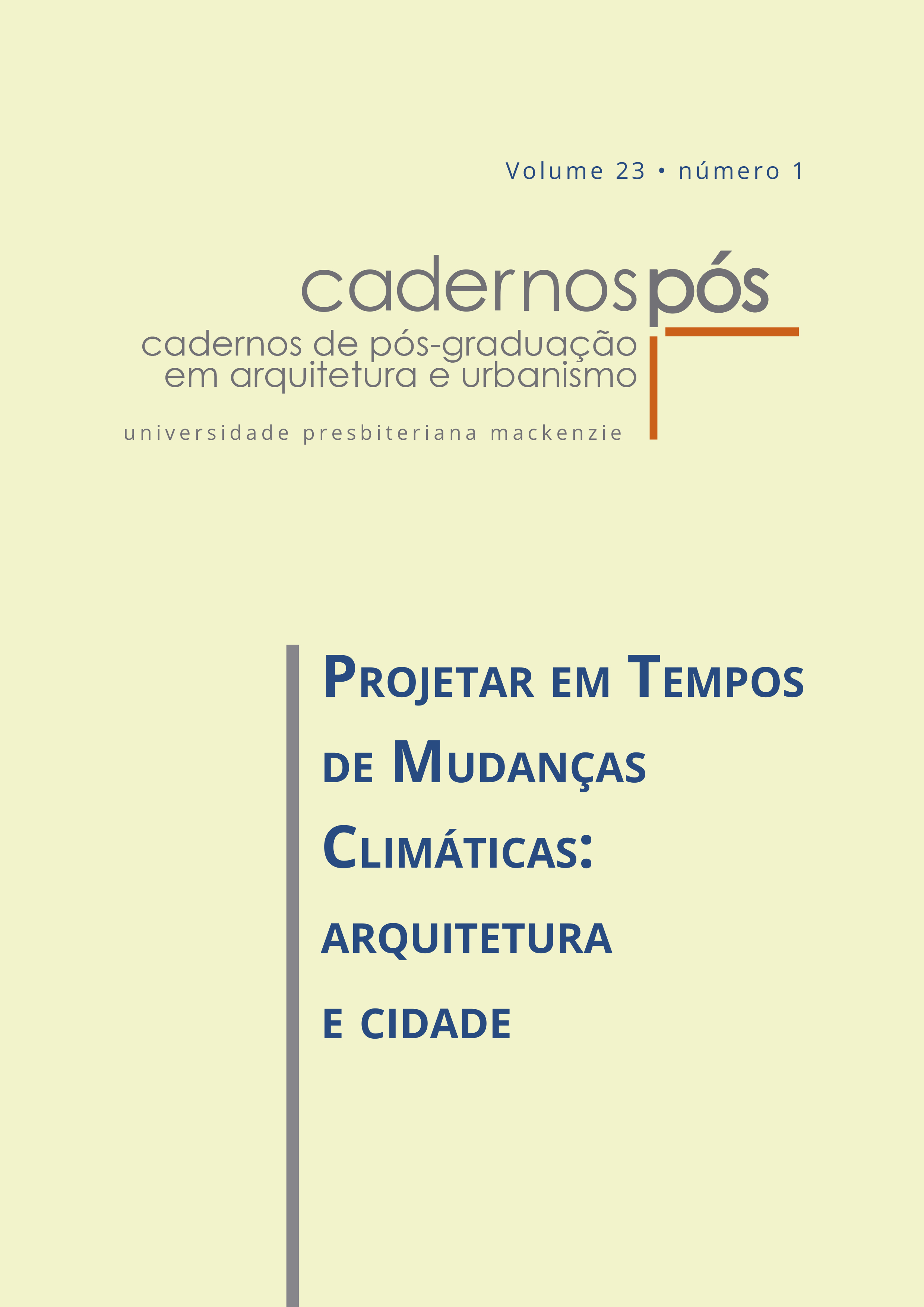Validación y revisión del agrupamiento de ciudades brasileñas en grados-día de calefacción y refrigeración
DOI:
https://doi.org/10.5935/cadernospos.v23n1p70-90Palabras clave:
Cambio climático; Grados de enfriamiento y calentamiento días; Agrupación; Clasificación climática.Resumen
Estimar el consumo de energía para el acondicionamiento ambiental es un punto clave para determinar el consumo de energía de un edificio. La energía requerida para el aire acondicionado se puede utilizar para cuantificar el rigor climático de un lugar determinado. Sin embargo, Brasil no tiene normas técnicas y/o zonificación estabelecidas por un método de cálculo para la definición de grados-días. Este trabajo tiene como objetivo presentar la actualización de la propuesta de zonificación basada en el grado-día, elaborada por Stensjö, Ferreira e Loura (2017), a partir de datos de 317 ciudades brasileñas que utilizan las Normales Climatológicas (1961-1990). La clasificación del nuevo conjunto de Normales Climatológicas para el período de 1981 a 2010 subestima los ajustes en el proceso de definición de la temperatura base para grados-días de calentamiento. Para el desarrollo, se siguió el método propuesto y las mismas referencias utilizadas por Stensjö, Ferreira e Loura (2017) para el establecimiento de temperaturas base, cálculos de grados-día y agrupación. En cuanto a la clasificación, el artículo investiga tres posibilidades para identificar la más adecuada para la nueva base de datos. Los resultados demostraron la robustez del método, permitieron el refinamento del proceso de clasificación, así como la identificación de tendencias de demanda de energía para los hogares brasileños.
Descargas
Citas
ASSIS, E. S. de. Método integrado de análise climática para arquitetura aplicado à cidade de Belo Horizonte, MG. In: VI ENCONTRO NACIONAL DE CONFORTO NO AMBIENTE CONSTRUÍDO E III ENCONTRO LATINO-AMERICANO SOBRE CONFORTO NO AMBIENTE CONSTRUÍDO (ENCAC/ELACAC), 2001, São Pedro. Anais do VI Encontro Nacional de Conforto no Ambiente Construído/ III Encontro Latino-Americano de Conforto no Ambiente Construído, São Paulo,
ANTAC, 2001. 1 CD-ROM.
BAI, L. et al. A new approach to develop a climate classification for building energy efficiency addressing Chinese climate characteristics. Energy, v. 195, p. 1-14, 2020. DOI 10.1016/j.energy.2020.116982
BAI, L.; WANG, S. Definition of new thermal climate zones for building energy efficiency response to the climate change during the past decades in China. Energy, v. 170. p. 709-719, 2019. DOI 10.1016/j.energy.2018.12.187
BERARDI, U.; JAFARPUR, P. Assessing the impact of climate change on building heating and cooling energy demand in Canada. Renewable and Sustainable Energy Reviews, v. 121, p. 1-12, 2020. DOI 10.1016/j.rser.2019.109681
D’AMICO, A. et al. Building energy demand assessment through heating degree days: the importance of a climatic dataset. Applied Energy, v. 242, p. 1285-1306, 2019. DOI 10.1016/j.apenergy.2019.03.167
DAY, T. Degree-days: theory and application TM4. London: The Chartered Institution of Building Services Engineers (CIBSE), 2006.
DEAR, R. J. de.; BRAGER, G. S. Thermal comfort in naturally ventilated buildings: revisions to ASHRAE Standard 55. Energy and Buildings, v. 34, n. 6, p. 549-561, July 2002. DOI 10.1016/S0378-7788(02)00005-1 ELETROBRAS. Pesquisa de posse e hábitos de uso de equipamentos elétricos na classe residencial. Rio de Janeiro: Procel, 2019. Disponível em: https://q.eletrobras.com/pt/Paginas/PPH-2019.aspx. Acesso em: 2 fev. 2023.
GIVISIEZ, G. H. N.; OLIVEIRA, E. L. de. (org.). Demanda futura por moradias: demografia, habitação e mercado. Niterói, RJ: Universidade Federal Fluminense, 2018.
GIVONI, B. Comfort, climate analysis and building design guidelines. Energy and Buildings, v. 18, n. 1, p. 11-23, 1992. DOI 10.1016/0378-7788(92)90047-K
HEIDARI, S.; SHARPLES, S. A comparative analysis of short-term and long-term thermal comfort surveys in Iran. Energy and Buildings, v. 34, n. 6, p. 607-614, 2002. DOI 10.1016/S0378-7788(02)00011-7
INSTITUTO NACIONAL DE METEOROLOGIA. Normais Climatológicas do Brasil: 1961-1990. Brasília, DF: INMET, 2009. p. 465.
INSTITUTO NACIONAL DE METEOROLOGIA. Normais Climatológicas do Brasil: 1981-2010. Brasília, DF: INMET, 2018.
INVIDIATA, A. et al. Análise de agrupamento de 411 cidades brasileiras baseado em indicadores de desempenho de edificações residenciais naturalmente ventiladas. In: XVI ENCONTRO NACIONAL DE TECNOLOGIA DO AMBIENTE
CONSTRUÍDO, 2016, São Paulo. Anais [...]. São Paulo, ANTAC, 2016.
KHEDARI, J. et al. Thailand ventilation comfort chart. Energy and Buildings, v. 32, n. 3, p. 245-249, 2000. DOI 10.1016/S0378-7788(00)00050-5
LOURA, R. M.; FERREIRA, C. C.; STENSJÖ, I. P. Análise comparativa da classificação e agrupamento das cidades brasileiras em graus-dia de aquecimento e resfriamento a partir das Normais Climatológicas 1961-1990 e 1981-2010. In: CONGRESSO LUSO-BRASILEIRO PARA O PLANEJAMENTO URBANO REGIONAL, INTEGRADO E SUSTENTÁVEL (PLURIS 2020), 9. Águas de Lindoia: [s.n.], 2021.
PEREIRA, I. M.; ASSIS, E. S. Avaliação de modelos de índices adaptativos para uso no projeto arquitetônico bioclimático. Ambiente Construído, v. 10, n. 1, p. 31-51, 2010. DOI 10.1590/S1678-86212010000100002
ROAF, S.; CRICHTON, D.; NICOL, F. Adapting buildings and cities for climate change: a 21st century survival guide. 2nd ed. UK: Routledge, 2009.
RORIZ, M. Segunda proposta de revisão do zoneamento bioclimático do Brasil. São Carlos: Associação Nacional de Tecnologia do Ambiente Construído (ANTAC), 2012.
STENSJÖ, I. P. FERREIRA, C. C.; LOURA, R. M. Classificação e agrupamento das cidades brasileiras em graus-dia de aquecimento e resfriamento: 1960 a 2013. Urbe – Revista Brasileira de Gestão Urbana, v. 9, n. 1, p. 286-300, 2017.
DOI 10.1590/2175-3369.009.SUPL1.AO03
UNITED NATIONS. World population prospects: the 2012 revision. New York, 2013. Disponível em: https://www.un.org/en/development/desa/publications/world-population-prospects-the-2012-revision.html#:~:text=The%20report%2C%20World%20Population%20Prospects,to%201.8%20billion%20in%20205 Acesso em: 2 fev. 2023.
VECCHI, R. et al. Application of the adaptive model proposed by ASHRAE 55 in the Brazilian climate context: raising some issues. In: 8TH WINDSOR CONFERENCE.London, 2014. p. 13.
Descargas
Publicado
Cómo citar
Número
Sección
Licencia
Derechos de autor 2023 Camila Carvalho Ferreira, Rejane Magiag Loura

Esta obra está bajo una licencia internacional Creative Commons Atribución 4.0.
Autores que publican en esta revista concuerdan con los siguientes términos:
a) Autores mantienen los derechos autorales y conceden a la revista el derecho de primera publicación, con el trabajo simultáneamente licenciado bajo la Licencia Creative Commons Attribution que permite la divulgación del trabajo con reconocimiento de la autoría y publicación inicial en esta revista.
b) Autores tienen autorización para asumir contratos adicionales por separado, para distribución no exclusiva de la versión del trabajo publicada en esta revista (ej.: publicar en repositorio institucional o como capítulo de un libro), indicando que fue publicado originalmente en esta revista, con el enlace del artículo.








 Todo o conteúdo de Cadernos de Pós-Graduação em Arquitetura e Urbanismo está licenciado sob
Todo o conteúdo de Cadernos de Pós-Graduação em Arquitetura e Urbanismo está licenciado sob 